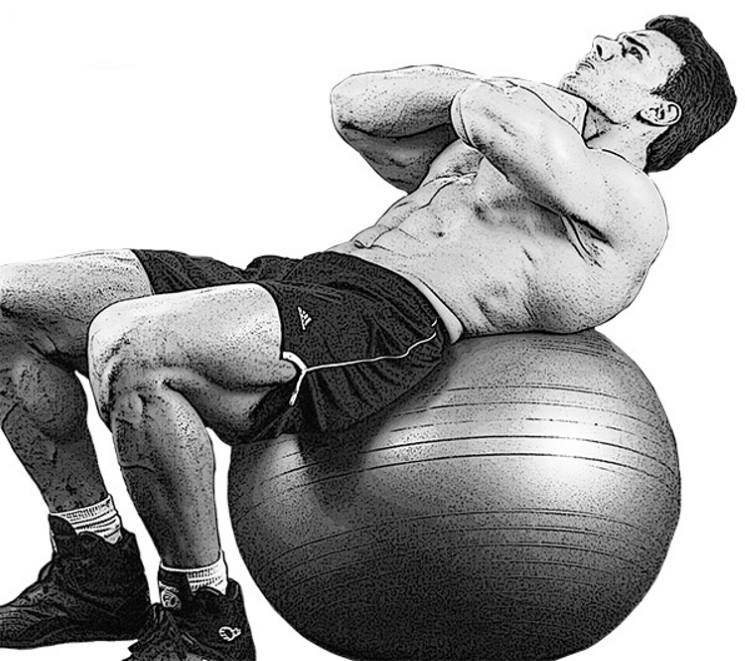It’s a common truth that the process of sharpening your abs requires you to speed up your metabolism with workout, cut down on your calorie intake, and do a tons of cardio. Naturally, you won’t get far without efficient abs training exercises.
The best abs exercises are those that work on shortening and tightening the muscle fibres. Stability ball crunches is an exercise that delivers optimal contraction of abs fibres, and at the same time protects the back. One of the greatest advantages of doing the crunches on a stability ball is that it prevents resting your shoulders and head between the reps, resulting with sustained tension throughout the exercise. According to the studies, the activity of the abdominal muscle can double by performing the crunches on a stability ball.
Anatomy of the Exercise
The rectus abdominis is a paired muscle. It’s two halves are separated by the thin fibrous structure called linea alba. Three to four horizontal tendinous intersections traverse the rectus abdominis separating the muscle into six to eight muscle belies. The rectus abdominis’ short muscle fibers go from one tendinous intersection to other. By contracting and tightening the rectus abdominis, you force these fibres to swell, creating the six pack appearance. Of course, if they are layered with fat, the swelling will not be visible.
The crunch generally relies on contracting both halves of rectus abdominis, which forces the forward movement of your head and chest, bringing them closer to your body. Although most of the abs exercises trigger contraction and shortening of muscle fibres in all of the blocks, with crunches this activity is mainly focused in the upper two rows. However, by performing the stability ball crunches, you also effectively activate the lower row fibres.
This exercise will also accentuate the external obliques. Their muscle fibres run on both sides of rectus abdominis, connecting the lower ribs with the pelvis and the hip, forming a fan-shaped muscle. These muscle are involved both in flexing and twisting the torso. If you contract them simultaneously they move the head toward the feet. The twisting motion is achieved when the contraction is unilateral.
The internal oblique lies beneath the external obliques. It’s fibres run perpendicularly in respect to the external obliques and are attached to the thoracolumbar fascia in the lower back, the iliac crest and groin ligament. The internal obliques are attached to the last three ribs. Their function is similar to that of the external obliques, allowing the torso to flex and twist.
How To Perform Stability Ball Crunches
The stability ball exercise effectively targets the upper two rows of rectus abdominis, and the external obliques.
1. Sit on a stability ball, and roll yourself out until your whole back is lying on the ball centred between your shoulder blades. Your knees are bended and your feet flat on the floor, creating a right angle with your legs.
2. At the starting position, the ball should be positioned in the lumbar region of your back.
3. Place your hands on each side of your head holding it gently at the temples. Your elbows should be pointed to the sides and away. Avoid putting your hands behind your head and interlacing the fingers, because you may be tempted to cheat the movement as you grow tired by starting to support your head and bending the neck forward. One of the most important things about all ab exercises is that you should let the torso do the work.
4. Keep an eye on breathing. Inhale at the starting position, and exhale during the upward movement. Start the movement by lifting your shoulders an inch or two. Do not roll the ball as you raise your shoulders and head, but press the lower back deeper into it, feeling the rectus abdominis contract. You should also avoid dropping down your hips when executing this phase of the movement.
5. Continue the movement by lifting the torso further up, taking the shoulder blades off the ball. However, when doing this movement you should avoid bending your shoulders and rounding the back as you take the chin towards your chest during the crunch. Hold for two seconds tensing your abdominals.
6. The third phase of the exercise continues by tilting the pelvis forward and up as you bring your shoulders closer to your hips. This is crucial if you want to activate the last row of rectus abdominis muscle. Squeeze them hard and hold for 3 more seconds, by tilting the pelvis at the same time. This puts the finishing touch of the exercise, activating the abdominal wall fibres with greater intensity.
7. Start lowering your body down in controlled and slow movement, inhaling as you get back to the starting position.

Repeat the movement.

